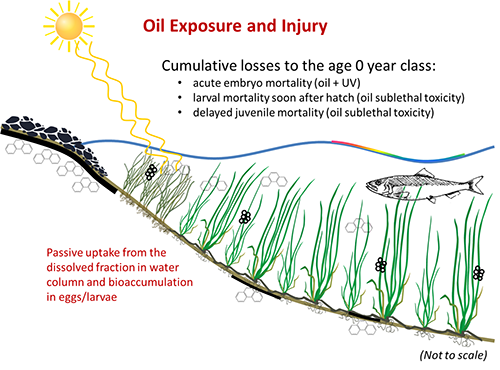New Publication Released on Potential Population-Level Impacts of Oil Spills on Pacific Herring
FEB. 26, 2024 — Published in early February, a new publication, “Potential population-level impacts of future oil spills on Pacific herring stocks in Puget Sound,” reports on research carried out by OR&R’s Assessment and Restoration Division and the Northwest Fisheries Science Center to model the responses of Puget Sound Pacific herring stocks to simulated oil spills.

Oil spills threaten the productivity of marine forage fish, including Pacific herring, which spawn in shallow shoreline habitats. Decades of research have led to an understanding of the toxicity of petroleum-derived contaminants to early life stages of herring, but the impacts of oil spills at the population scale remain uncertain. This study evaluated spill scenarios that varied in their duration and magnitude of impacts on young-of-the-year herring in both healthy and declining Puget Sound stocks. It evaluated the ability of a stock assessment model to detect population-level impacts resulting from oil-induced herring losses.
Population modeling is limited in its ability to detect spill effects by the high degree of natural variability and observation error in counting spawning aggregations. A spill scenario that impacted multiple years of herring spawn caused significant changes in population metrics, but shorter duration impacts were not discernible from baseline stock variability. The model showed that a strong predictor of the impacts of a spill that injures young-of-the-year herring is the pre-existing stock growth or decline trajectory. Healthy stocks are more likely to recover from a short term spill impact, whereas extinction risk is accelerated for stocks that were in decline at the time of a spill. Highly variabile natural processes, such as dispersal, predation pressure, and prey abundance, also strongly influence stock responses to oil spills and can mask or exacerbate impacts at a population level. The publication discusses the usefulness and limitations of stock assessments and population modeling as a basis for estimating injury from oil spills in marine forage fish resources and scaling biological effects from molecular initiating events in the cells of individual fish to the dynamics of wild forage fish populations.
